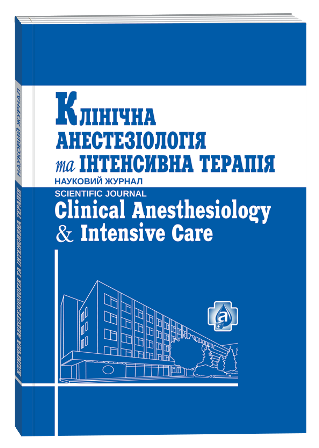FEATURES OF ANESTHETIC MANAGEMENT FOR TOTAL HIP ARTHROPLASTY IN THE ELDERLY
Keywords:
central neuraxial blockade, hip arthroplasty, venous thromboembolismAbstract
Background — to prove a necessity of central neuraxial blockade in hip replacement in the elderly patients with evaluating their safety. Methods. Research group included 137 patients with fractures of diaphysis and femoral neck. All patients were 60–90 years old with concomitant chronic pathology and had 3–4 class by ASA scale. Catheterization of the epidural space was performed in all patients, most often at the level L3–L4, the catheter was held in a cranial direction. Adequacy of anesthesia in such cases was assessed by blood pressure (BP), heart rate, ECG, blood saturation of oxygen, and the presence or absence of pain in case of moving the limb fracture zone. Results. 124 patients operated in the Orthopedics Department of the Odessa Regional Clinical Hospital had adequate epidural anesthesia, and combined anesthesia in 13 patients: epidural anesthesia (EDA) + unilateral spinal anesthesia. Both groups had stable hemodynamic parameters, but patients with combined anesthesia had systolic BP fall by 23% as compared with 12.5% for patients with EDA. Anticoagulant and fibrinolytic effects of central neuraxial blockade was confirmed by the instrumental method — low-frequency pyezoelectric thromboelastography. Conclusions. The use of combined methods allows to get adequate pain relief, minimal hemodynamic and metabolic disorders, the ability to manage the duration of anesthesia, and to conduct adquate post-operative analgesia with anticoagulation and fibrinolytic effects.
References
Лист В. Анестезия у пожилых больных / В. Лист // Актуальные проблемы анестезиологии и реаниматологии. Освежающий курс лекций. – Архангельск, 1998. – С. 67–71.
Прощаев К. И. Полиморбидность в гериатрической практике: исторические аспекты, современное состояние и перспективы решения проблемы / К. И. Прощаев // Успехи геронтологии. – 2011. – № 2. – С. 285–289.
Лазебник Л. Б. Полиморбидность у пожилых / Л. Б. Лазебник // Сердце. – 2007. – № 7. – С. 25–27.
Овечкин А. М. Использование длительной эпидуральной анальгезии для предупреждения операционного стресс-ответа и послеоперационных болевых синдромов / А. М. Овечкин, В. К. Решетняк // Боль. – 2003. – № 1. – С. 61–65.
Кобеляцкий Ю. Ю. Современные аспекты периоперационного обезболивания в травматологии и ортопедии / Ю. Ю. Кобеляцкий // Здоровье Украины. – 2008. – № 8. – С. 29–30.
Прибиткова І. М. Методологiя, теорiя та практика соцiологiчного аналiзу сучасного суспiльства / І. М. Прибиткова // Збірник наукових праць. – Вип. 15. – Х., 2009. – С. 382–391.
Sharrock N. E. Hypotensive epidural anesthesia for total hip arthroplasty: a review / N. E. Sharrock // Acta Оrthop. Scand. – 1996. – Vol. 67, N 1. – P. 91–107.
Macfarlane A. J. R. Does regional anaesthesia improve outcome after total hip arthroplasty? A systematic review / A. J. R. Macfarlane // Br. J. Anaesth. – 2009. – Vol. 103, N 3. – P. 335–345.







